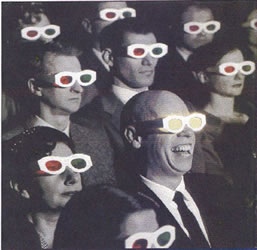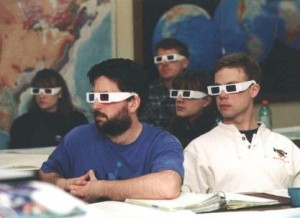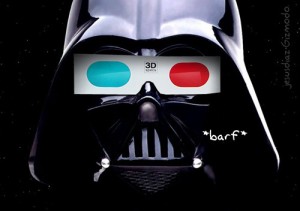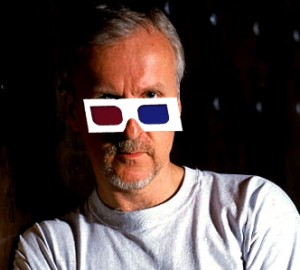 I recently interviewed Roger Deakins and asked him about the Walter Murch article in which he systematically tore apart 3-D. Deakins hadn’t read it, but what he kept repeating was – that though he spent some time working on 3-D animated films – he felt 3-D was a ride. I think one can guestimate that Deakins is not a fan. But where Murch and many others have gone about attacking or defending 3-D by our ability and psychic space to respond to it, my issue with 3-D is one of my continuing problems with cinema. I’ve never expressed much happiness with the format, though I’ve seen some fun films done in 3-D (My Bloody Valentine, Jackass 3-D) that I would recommend as 3-D experiences. But ultimately I don’t like the format at all. I think my problem is how we’re asked as an audience to share our imagination.
I recently interviewed Roger Deakins and asked him about the Walter Murch article in which he systematically tore apart 3-D. Deakins hadn’t read it, but what he kept repeating was – that though he spent some time working on 3-D animated films – he felt 3-D was a ride. I think one can guestimate that Deakins is not a fan. But where Murch and many others have gone about attacking or defending 3-D by our ability and psychic space to respond to it, my issue with 3-D is one of my continuing problems with cinema. I’ve never expressed much happiness with the format, though I’ve seen some fun films done in 3-D (My Bloody Valentine, Jackass 3-D) that I would recommend as 3-D experiences. But ultimately I don’t like the format at all. I think my problem is how we’re asked as an audience to share our imagination.
To be fair, one of my earlier cinematic memories was being at a public library watching Creature of the Black Lagoon. The film was entertaining us brats (I remember there was some running around, but not from me), and the highlight of the film was easily the sequence where there’s a fossilized hand that reaches out across the screen. It’s a show stopper. I also remember TV networks showing 3-D movies locally, selling 3-D glasses at the local 7-11. As a kid I loved the stuff, but I was a bit too young for the wave of 3-D films that came in the early 80’s. My first theatrical (partly) 3-D movie was Freddy’s Dead: The Final Nightmare, where you are instructed to put on the glasses for the last twenty minutes. It was a stupid conceit, but it was also a stupid movie, so what are you going to do? Later there would be Imax films that were in 3-D, and I’d dutifully check in, finding them more mature than the more polarized diorama-looking 3-D of the past. And when 3-D started popping up again with greater frequency, it didn’t seem like the worst thing with Corlaine and My Bloody Valentine. But what I liked about it as a kid was that it was different, I liked the idea more than the actual experience, and generally the idea was better than experience itself. What I liked about it two years ago was that filmmakers either embraced the nature of their filmmaking (exploitation, stop-motion) and found that 3-D was beneficial or didn’t interfere.
 Now, post-Avatar, it’s everywhere and used on some horrible movies to hopefully jack up ticket sales (Clash of the Titans, The Last Airbender, likely Thor) and now we’re in a position where we’re going to keep getting 3-D films for a while now. The battle lines have been drawn, and I hate the format. I’ve been watching 3-D films long enough in their current iteration and I now no longer want to see any more 3-D films. Not just because of the occasional headaches, and not because it doesn’t work for me – though sometimes I question if my disinterest is because maybe I’m not getting the same depth as the format’s fans. No, my problem is this: Whenever I notice 3-D, I stop watching the movie. That’s because of a simple aspect of filmmaking and storytelling which is that the minute you notice dimension, you’re no longer engaged. I think a fundamental aspect of storytelling is that you’re supplying part of the narrative with your imagination, and any time something tries to be more real it ultimately becomes less so.
Now, post-Avatar, it’s everywhere and used on some horrible movies to hopefully jack up ticket sales (Clash of the Titans, The Last Airbender, likely Thor) and now we’re in a position where we’re going to keep getting 3-D films for a while now. The battle lines have been drawn, and I hate the format. I’ve been watching 3-D films long enough in their current iteration and I now no longer want to see any more 3-D films. Not just because of the occasional headaches, and not because it doesn’t work for me – though sometimes I question if my disinterest is because maybe I’m not getting the same depth as the format’s fans. No, my problem is this: Whenever I notice 3-D, I stop watching the movie. That’s because of a simple aspect of filmmaking and storytelling which is that the minute you notice dimension, you’re no longer engaged. I think a fundamental aspect of storytelling is that you’re supplying part of the narrative with your imagination, and any time something tries to be more real it ultimately becomes less so.
Of course this is made tricky by the advancements in technology (even if you still have to wear glasses, and as someone who wears glasses already, it’s hard not to notice the hardware). Ultimately 3-D technology – even in its newer more polished iteration – can do some things better than it used to – like creating depth. But there’s been nothing in 3-D that I’ve found as effective as one of the opening shoots in Cliffhanger, when I got a sense of vertigo from how the camera moved around Sylvester Stallone and showed that what he was doing was not digital trickery. Ultimately the limits of 3-D are the problems of trying to create an immersive world. There is a level to which – by forcing the fact – it becomes less immersive to me because I’m not thinking about the narrative but the trickery. Much like a lot of CGI effects, I’m constantly aware of the notion that what I’m looking at isn’t really in three dimensions, and I’m not guessing how it was accomplished, so much as assured it’s a byproduct of digital technology. Perhaps I’m of a generation too aware of what computers can do, and I’m aware of that. I think my problem might have something to do with the uncanny valley, but ultimately I tend to explain my problem with 3-D in these terms. Imagine 3-D creating a perfect lust object. You can see this form in all dimensions, and you may want to have sex with it, but any motions toward it break the spell because the chasm between you and the object is such that the fact that it isn’t real eventually becomes frustrating. Whereas when I’m intellectually stimulated by a sequence that involves seduction I tend to find the build up to sex hotter than anything that could be done with 3-D, because I know how sex feels, and watching people do it interferes with my own fantasy, whereas watching two people look at each other and want to fuck is way more exciting often. I find it hotter because my intellect is doing the work, versus just relying on the visual. I will not deny the visual works, but in either case, it’s not the same as the real thing.
 One of the reasons why I love The Muppet Show is that the characters are obviously puppets – because we make the leap to accept the characters as real. And that schism is what makes great art, that we can project and create as much as the artist. I prefer art where we the audience have to fill in the blanks, and have a shared responsibility in the heavy lifting (which may explain why my year-end list featured Dogtooth and Never Let Me Go). We acknowledge the fantasy (be it just in “A Long, long time ago, in a galaxy far, far away”) so we know what we’re dealing with. With Muppets, we know that there is a hand in Kermit, but we can watch the puppet make emotions- it’s there and present. This also gets into the problem with CGI, but it’s a similar problem. As an audience member, I prefer tangible phoniness played straight, versus the always noticeable accentuations of digital technology. But I find with stop-motion, and puppetry there is usually a human artistry visible that makes these works endearing, more so than the best of the computer world interacting with flesh. If we recognize the phoniness, at a certain point you stop questioning it in ways that I’ve found difficult with digital. I’m reminded of Vern talking about how someone was questioning how they got Arnold Schwarzenegger into T:4, and explaining it was digital technology. With computers the sense of how magic is accomplished is readily explainable.
One of the reasons why I love The Muppet Show is that the characters are obviously puppets – because we make the leap to accept the characters as real. And that schism is what makes great art, that we can project and create as much as the artist. I prefer art where we the audience have to fill in the blanks, and have a shared responsibility in the heavy lifting (which may explain why my year-end list featured Dogtooth and Never Let Me Go). We acknowledge the fantasy (be it just in “A Long, long time ago, in a galaxy far, far away”) so we know what we’re dealing with. With Muppets, we know that there is a hand in Kermit, but we can watch the puppet make emotions- it’s there and present. This also gets into the problem with CGI, but it’s a similar problem. As an audience member, I prefer tangible phoniness played straight, versus the always noticeable accentuations of digital technology. But I find with stop-motion, and puppetry there is usually a human artistry visible that makes these works endearing, more so than the best of the computer world interacting with flesh. If we recognize the phoniness, at a certain point you stop questioning it in ways that I’ve found difficult with digital. I’m reminded of Vern talking about how someone was questioning how they got Arnold Schwarzenegger into T:4, and explaining it was digital technology. With computers the sense of how magic is accomplished is readily explainable.
 I was also recently watching some old movies like The Driver and Dirty Harry. I found they had more breathtaking action sequences than anything I’d seen theatrically in quite some time. It’s because I believed that the cars were doing what they were doing, and that the characters were invested. I think the Bourne shakey-cam stuff works fine, but ultimately that constant movement becomes a way to distract more than enhance, because it doesn’t clarify so much as obfuscate.
I was also recently watching some old movies like The Driver and Dirty Harry. I found they had more breathtaking action sequences than anything I’d seen theatrically in quite some time. It’s because I believed that the cars were doing what they were doing, and that the characters were invested. I think the Bourne shakey-cam stuff works fine, but ultimately that constant movement becomes a way to distract more than enhance, because it doesn’t clarify so much as obfuscate.
Back to Avatar: The World of Pandora – to me – was made way more involving on my second pass on Blu-ray because it was removed from the 3-D environment, and I could appreciate the alien vegetation. I guess you can get both in 3-D, but I think the third dimension gets in the way. I also think one of the best films of the last decade was Lars von Trier’s Dogville. Part of what makes it so great is that there aren’t really sets, and the film then becomes about how that doesn’t matter. I guess this makes me a Brechtian, but we all know what’s going on is phony, so acknowledging the artifice works. It works because great films with heightened reality do well to acknowledge their silliness in one way or another.
 The third dimensional boom in cinema was brought about partly because of the inflated ticket prices – not so much audience interest in the format. People will go see Inception just as readily as they will Toy Story 3. But as long as tickets sell, we’re stuck in a world where 3-D seems viable. To me it’s like mixing a classic album in DTS 5.1 or colorizing. Some people enjoy that, but it adds nothing to my experience (and may prove distracting) because it’s unnecessary for the magic to work. And in pursuing the format, it distract from what makes movies great: The connection to material that is indelible. I can’t think of a single one of my favorite films that would be better in 3-D. but I also haven’t seen the 3-D film that makes me think it’s a format worth more than gimmickry.
The third dimensional boom in cinema was brought about partly because of the inflated ticket prices – not so much audience interest in the format. People will go see Inception just as readily as they will Toy Story 3. But as long as tickets sell, we’re stuck in a world where 3-D seems viable. To me it’s like mixing a classic album in DTS 5.1 or colorizing. Some people enjoy that, but it adds nothing to my experience (and may prove distracting) because it’s unnecessary for the magic to work. And in pursuing the format, it distract from what makes movies great: The connection to material that is indelible. I can’t think of a single one of my favorite films that would be better in 3-D. but I also haven’t seen the 3-D film that makes me think it’s a format worth more than gimmickry.